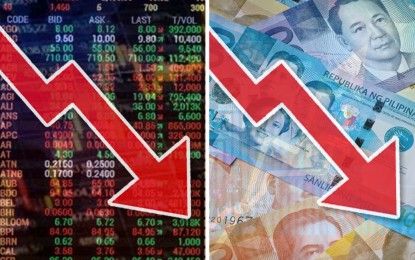[2.6] 1월 인플레이션 보고서 앞두고 주식, 페소 하락
컨텐츠 정보
- 15,600 조회
본문
MANILA – 현지 증권 거래소의 주요 지수는 2023년 1월 인플레이션 보고서 발표를 앞두고 월요일 하락세로 마감했으며 페소는 미국 달러에 대한 조정으로 추적된 54 수준으로 떨어졌습니다.
지난주 며칠간 상승한 필리핀 증권거래소 지수(PSEi)는 1.29%(90.77포인트) 하락한 6,936.61포인트를 기록했다.
전체 주가는 0.83%(30.78포인트) 하락한 3,674.68포인트로 집계됐다.
서비스는 1.33% 하락한 후 부문별 지표 중 가장 큰 하락폭을 기록했고 금융이 1.22%로 그 뒤를 이었습니다. 재산, 1.21%; 지주회사, 1.04%; 산업, 0.79%; 및 광업 및 석유, 0.33%.
거래량은 총 12억 4천만 주, PHP99억 5천만 달러입니다.
Decliners는 103에서 79로 상승세를 이끌었고 51주는 변경되지 않았습니다.
"필리핀 주식은 내일(1월 7일) 1월 인플레이션 인쇄를 앞두고 매도되었고 투자자들은 전 세계적으로 최신 경제 업데이트를 기다리는 많은 사람들과 함께 현금을 보관했습니다."라고 Regina Capital Development Corporation(RCDC)의 영업 책임자인 "Luis Limlingan"이 말했습니다.
필리핀 통계청(PSA)은 올해 첫 달의 가격 인상률을 발표할 예정이며 BSP(Bangko Sentral ng Pilipinas)는 7.5~8.3% 범위로 예상합니다.
지난해 12월 인플레이션율은 8.1%로 더욱 높아져 2008년 11월 이후 최고치를 기록했다.
림링안 총재는 국내 인플레이션 추이에 대한 전망을 묻는 질문에 "서구 경제의 소비자물가지수(CPI)가 둔화되기 시작했다는 점을 감안할 때 전체적으로 인플레이션이 정점에 도달했을 가능성이 있다"고 말했다.
“낮은 연료 비용은 주요 동인 중 하나가 될 것입니다. 동시에 현지 통화가 꾸준히 상승하여 수입 비용도 낮아졌습니다.”라고 그는 말했습니다.
한편 "Limlingan"은 "일부 다른 투입물은 주로 음식과 함께 높은 상태를 유지하고 있습니다."라고 말했습니다.
그는 국제 시장의 최근 유가가 "미국의 산업 관련 공장 주문이 감소하고 미국 달러가 강세를 보이면서 비미국 구매자들에게 원유 가격이 더 비싸지면서" 하락했다고 말했습니다.
그는 브렌트유 선물은 배럴당 1.04% 하락한 81.98달러, WTI는 0.84% 하락한 배럴당 75.77달러라고 말했다.
한편 현지 통화는 지난 금요일 종가 53.68달러에서 달러당 54.39달러로 하락했습니다.
이전 세션의 53.93 시작에서 54.15에 첫 거래일을 열었습니다.
54.47에서 54.12 사이에서 거래되어 평균 54.279가 되었습니다.
거래량은 지난 주 거래 종료 시 11억 7천만 달러에서 10억 5천만 달러로 감소했습니다.
RCBC(Rizal Commercial Banking Corporation)의 수석 이코노미스트 "Michael Ricafort"는 페소의 약세가 지난주 후반 3일간의 랠리 이후 "건전한 조정으로 간주된다"고 말했습니다.
그는 2023년 1월 실업률이 53년 만에 최저치인 3.4%로 예상보다 강세를 보인 데 따라 미국 달러가 강세를 보였다고 말했습니다.
"Ricafort"는 또한 올해 첫 달에 비농업 일자리가 517,000개 증가하여 6개월 만에 최고치를 기록했다고 언급했습니다.
그는 최근 미중 문제에 대한 보도는 또한 캐롤라이나 연안에서 중국의 첩보 풍선이 미국에 의해 격추되었다는 소식에 투자자들을 걱정하게 했으며 미국 정부가 미국 국무장관 안토니 블링켄의 중국 방문을 연기했다고 말했습니다. 의심되는 감시 풍선.
화요일에는 현지 통화가 미국 달러당 54.25에서 54.50 사이에서 거래될 것으로 예상됩니다. (PNA)
This is the Original Article from PNA NEWS
[2.6] Stocks, peso slip ahead of January inflation report
MANILA – The local bourse’s main index closed lower on Monday ahead of the release of the January 2023 inflation report while the peso slipped to 54-level, which has been traced to correction against the United States dollar.
After rising several days last week, the Philippine Stock Exchange index (PSEi) lost 1.29 percent, or 90.77 points, to 6,936.61 points.
It was tracked by counters across-the-board, with All Shares down by 0.83 percent, or 30.78 points, to 3,674.68 points.
Services posted the biggest decline among the sectoral gauges after it slipped by 1.33 percent and was trailed by Financials, 1.22 percent; Property, 1.21 percent; Holding Firms, 1.04 percent; Industrial, 0.79 percent; and Mining and Oil, 0.33 percent.
Volume totaled 1.24 billion shares amounting to PHP9.95 billion.
Decliners led advancers at 103 to 79 while 51 shares were unchanged.
“Philippine stocks were sold ahead of the January inflation print tomorrow (January 7), and investors kept cash with many awaiting the latest economic updates globally,” said "Luis Limlingan," Regina Capital Development Corporation (RCDC) head of sales.
The Philippine Statistics Authority (PSA) is scheduled to release the rate of price increases for the first month of the year, which the Bangko Sentral ng Pilipinas (BSP) forecasts to range between 7.5 to 8.3 percent.
The inflation rate last December accelerated further to 8.1 percent, the highest since November 2008.
Asked for his projection on the path of domestic inflation rate, Limlingan told the Philippine News Agency that “it’s possible inflation as a whole has peaked given that the western economies’ CPI (consumer price index) have begun to decelerate.”
“Lower fuel costs would be one of the leading drivers. At the same time, the local currency has steadily appreciated, lowering import costs as well,” he said.
"Limlingan," meanwhile, said “some other inputs remain elevated, primarily with food.”
He said latest oil prices in the international market slipped “as US industrial-linked factory orders dipped while the greenback strengthened, making crude more expensive for non-American buyers.”
He said Brent crude futures went by down 1.04 percent to USD81.98 per barrel and the West Texas Intermediate (WTI) by 0.84 percent to USD75.77 per barrel.
Meanwhile, the local currency depreciated to 54.39 to a greenback from its 53.68 close last Friday.
It opened the week’s first trading day at 54.15 from the previous session’s 53.93 start.
It traded between 54.47 and 54.12, resulting in an average of 54.279.
Volume declined to USD1.05 billion from USD1.17 billion at the end of last week’s trading.
Rizal Commercial Banking Corporation (RCBC) chief economist "Michael Ricafort" said the peso’s weakness is “considered a healthy correction” after a three-day rally at the latter part of last week.
He said the US dollar strengthened due in part to the stronger-than-expected January 2023 jobs data, with unemployment rate down to 3.4 percent, the lowest in more than 53 years.
"Ricafort" also cited the 517,000 increase in non-farm jobs in the first month of the year, the highest in six month.
He said reports about the latest US-China issue also worried investors following news that alleged Chinese spy balloons off the Carolina coast were shot down by the US, and that the US government postponed US Secretary of Estate Antony Blinken’s China visit following the detection of the alleged surveillance balloon.
For Tuesday, the local currency is expected to trade between 54.25 to 54.50 to a US dollar. (PNA)
관련자료
-
이전
-
다음


